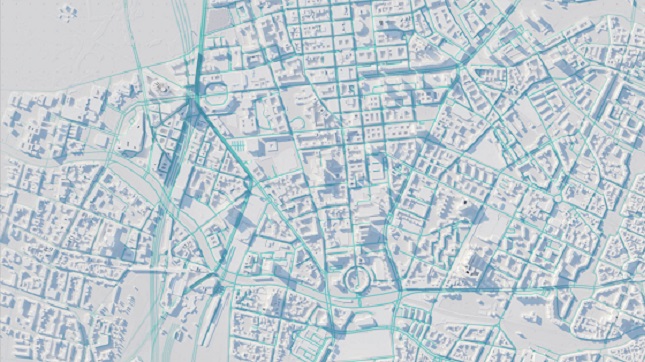Business-agnostic maps: Connecting the dots to unlock business value

Digital maps have become an integral part of our everyday lives, where they power our everyday commuting, food delivery and ride hailing services. For businesses today, maps are powerful tools to improve internal operations and customer experiences.
High demand for enterprise-grade map data and location services from both consumers and businesses have led to growing investment in digital mapping services. As a result, the global digital map market is projected to expand at a CAGR of 11.92% during the next five years, reaching USD 38.8 billion by 2027. The same applies to Southeast Asia, where increasing adoption of geospatial data information and solution in various business verticals are fuelling the growth for the region’s digital map market.
While we know that demand for digital map services have gone up, it’s also worth noting that in the last five years, the use cases for digital mapping and geospatial technology have become increasingly complex. Maps now require intelligent software, automation and quality protocols to capture and update in real-time to changes in the real world.
How are tomorrow’s businesses using digital maps?
As businesses accelerate their digital transformation, it’s essential for them to access fresh, accurate, and rich map content at a higher frequency. Think about a centimetre high definition, three-dimensional map that acts as a digital canvas overlaying onto our physical reality – this is going to redefine every busines and consumer experience.
Digital maps help visualise data, which is a valuable analytic for businesses as they can leverage insights obtained to improve customer experience, retain loyal customers, and gain new leads. For instance, one of Indonesia’s largest digital wallet services DANA is utilising HERE location services to bolster inclusive financial services in the country. With its ‘Nearby’ feature, DANA users can locate top-up agents near them – especially those in rural areas who are unable to top up their accounts via credit cards online – to top up their DANA account conveniently. This feature enhances customer experience and allows DANA to deliver convenience and more efficient, tailored digital offers to their customers.
Up-to-date and accurate maps further allow businesses and end consumers to plan smarter, more sustainable routes. In automotive, digital maps and location technology are powering connected cars that help drivers avoid obstacles, reduce risks on the road and make the driving experience more enjoyable. From advanced driver-assistance systems (ADAS) to smart navigation, major automotive brands are connecting vehicles and sharing data with other devices inside and outside the car. Such connected vehicles are delivering personalised digital experiences and remote connections that are more than welcome by consumers. Not to mention, this is also paving the way to fully autonomous vehicles in the near future.
VinFast, Vietnam’s leading manufacturer of premium automobiles, is an example of an automaker that is integrating location services – HERE ISA (Intelligent Speed Assistance) Map – into its new electric line-up to stay compliant with the European Union’s General Safety Regulations on ISA mandate aimed at improving driver safety.
Similarly, for the transport and logistics industry, business-to-business (B2B) relationships have intensified because of the increased market and consumer expectations on last mile delivery. To keep up with that – as well as to ensure supply chains remain resilient to disruption, supply chains are moving to a predictive model where businesses are using real-time estimated times of arrival (ETAs) and visibility tools to automate workflow management and decision-making.
As a result, digital maps and location technology have become the unifying links that bring disparate datasets – warehouse, fleet, vehicle, vessel, rail, air cargo, shipment and environmental data – together to gain insights that will help businesses save time, money and fuel. With location data, businesses can create accurate multimodal ETAs and replace time-consuming, manual processes, and focus on improving sustainability with more accurate route calculations.
So, what kind of map can help unlock business value?
Location data is the foundation to building a real-time digital representation of the world – one where businesses across verticals can benefit from. To do so, map building can only be done right by map providers who can orchestrate the publishing of the richest, most accurate and freshest map on the market.
However, for businesses to truly reap the benefits of a great map, they need to be able to seamlessly integrate location into their applications and overall business operations. This is where business-agnostic maps become critical. This means that businesses – regardless of the industry and size of the company – do not need to create any map from scratch, and instead could use the same location data to build solutions and integrate with existing applications that address their unique business needs. A business-agnostic map has location as the common denominator to provide companies the freedom to bring their own data, map, and services for location-based enrichment.
Rather than competing with businesses to develop personalised or localised maps, a business-agnostic map serves as an enabler for businesses to grow and scale. Be it from vehicles, satellite and aerial imagery, government or third-party sources, map providers who place location data at the core of detecting and processing real world changes, will triumph in having a more complete representation of the world.
What’s the new map industry standard for next-gen business?
We already know that thanks to modern technology such as machine learning and artificial intelligence, digital maps today are smart. They consist of orchestrated layers of data from countless sources to create value for data-driven businesses across many use cases – from automotive, transport & logistics, retail, to financial technology and more.
With the ever-evolving customer demands, next-generation businesses are relying on maps as digital products and services. These include leveraging location data for autonomous transportation, building smart and sustainable cities, and influencing the future of mobility – think ride hailing, food delivery and e-commerce.
As mentioned earlier in the article, the demand for maps and its applications have become increasingly complex. When you imagine where the future of maps is going, software that produces maps with the highest accuracy, coverage, and freshness for businesses of all types and enable businesses to seamlessly integrate them into their operations will be the key to open location for everyone. Ultimately, location data should be available for everyone and thanks to software, map making and maintenance will become a simplified process to support every business operations.
Ref: Global Digital Map Market Insight | 2022-2027, Digital Journal, September 2022
Author:

Abhijit Sengupta
Senior Director and Head of Business for Southeast Asia and India
HERE Technologies
Abhijit Sengupta is Senior Director and Head of Business, Southeast Asia & India at HERE Technologies. He was most recently appointed as as Co-Chair of the Smart Mobility Committee at the European Chamber of Commerce (Singapore) and is an existing member of the Logistics Council at the Internet and Mobile Association of India.
Published in Telematics Wire

